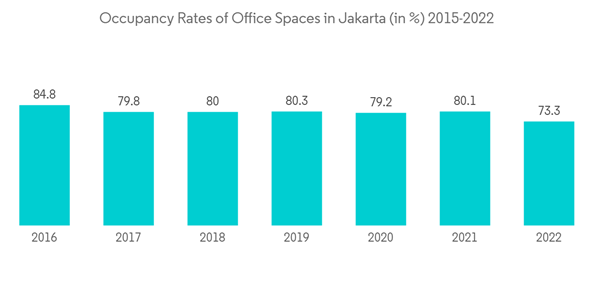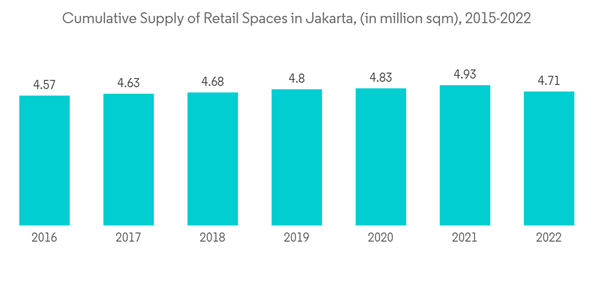The Indonesia Commercial Real Estate Market size is estimated at USD 21.04 billion in 2024, and is expected to reach USD 30.07 billion by 2029, growing at a CAGR of 7.40% during the forecast period (2024-2029).
Overall, improving trends in inquiries and transactions from those in 2021 were observed throughout the year, with demand coming mostly from tenants looking for office relocations and consolidations for 2022 and beyond.
After six consecutive quarters of market contraction trend, the Jakarta CBD office market recorded its first positive quarterly net-take-up of 17,900 sqm in the fourth quarter of 2021, indicating a very positive sign for market recovery in the near term.
The average occupancy rate of the CBD (Central Business District) office market decreased by 0.2%-70.4% by the end of December 2021, due mostly to the large additional supply. The base rental rate in Rupiah decreased further by 3.0% Q-o-Q in the fourth quarter of 2021, in line with weak demand and decreasing average occupancy of the market.
By the end of December 2021, the average base rental in Rupiah term stood at IDR 175,100 per sqm per month (a decrease of 9.1% YoY), while in USD equivalent, it stood at USD 12.3 per sqm per month (a decrease of 9.6% Y-o-Y). Meanwhile, service charges remained relatively unchanged over the fourth quarter of 2021.
This fourth AEON Mall in Indonesia, together with the Southgate Residence project, is expected to create a new one-stop urban lifestyle complex in South Jakarta. With the total addition of two new projects in 2021, the total full-year new supply of Jakarta retail centers in 2021 reached 70,000 sqm. Another two retail centers with approximately 73,000 sqm of retail space are expected to enter the Jakarta retail market by 2022.
The total refurbishment and transformation of Sarinah, the oldest retail center in Jakarta, was completed and was open to the public in March 2022. The total Jakarta retail supply will reach 4,716,400 sqm by the end of 2022. The overall Jakarta retail market was relatively stable during the last quarter of 2021. The occupancy rate stood at 76.7%, which increased slightly by 0.2% since the last quarter of 2021.
This product will be delivered within 2 business days.
Key Highlights
- The market is driven by the country's rapid population growth and high urbanization. The long-term outlook for commercial real estate looks positive for Indonesia, supported by solid economic growth and rising urbanization. The COVID-19 pandemic had a significant impact on the commercial real estate (CRE) sector in Indonesia. Commercial property transaction volumes and prices fell in 2020 as pandemic containment measures harmed economic activity and reduced demand for commercial property.
- Some markets, particularly in Asia, quickly rebounded from the initial shock, but long-term social distance limitations reduced occupier demand in the country's economy, contributing to a growing disparity in CRE prices across Indonesia and CRE segments (such as retail, office buildings, industrial, and multi-family buildings).
- Average land prices in Indonesia have been growing across the country. Prices continue to be highest in the capital city, Jakarta, which is the economic center of Indonesia.
- There is still much room for further developments to fulfill the demand for commercial real estate. To meet the rising property demand, the Indonesian government introduced several measures to expand the sector, such as decreasing key interest rates, providing tax incentives to Indonesian real estate investment trusts, and increasing the loan-to-value ratios.
- The Indonesian government authorized a budget of IDR 2.7 quadrillion (USD 190.1 billion) for 2022 in September 2021, with IDR 1.9 quadrillion (USD 133.8 billion) going to the central government and IDR 770 trillion (USD 54.2 billion) going the regional administration. Simultaneously, the government announced intentions in the budget to allocate IDR 384.8 trillion (USD 27.1 billion) to infrastructure.
Indonesia Commercial Real Estate Market Trends
The demand for office remains strong in the country
Some large leasing transactions were recorded during the fourth quarter of 2021, such as in MSIG Tower of about 15,000 sqm by an online education institution, in Medialand Tower by a logistics company of 5,500 sqm, and in Capital Place of 4,000 sqm by Nokia.Overall, improving trends in inquiries and transactions from those in 2021 were observed throughout the year, with demand coming mostly from tenants looking for office relocations and consolidations for 2022 and beyond.
After six consecutive quarters of market contraction trend, the Jakarta CBD office market recorded its first positive quarterly net-take-up of 17,900 sqm in the fourth quarter of 2021, indicating a very positive sign for market recovery in the near term.
The average occupancy rate of the CBD (Central Business District) office market decreased by 0.2%-70.4% by the end of December 2021, due mostly to the large additional supply. The base rental rate in Rupiah decreased further by 3.0% Q-o-Q in the fourth quarter of 2021, in line with weak demand and decreasing average occupancy of the market.
By the end of December 2021, the average base rental in Rupiah term stood at IDR 175,100 per sqm per month (a decrease of 9.1% YoY), while in USD equivalent, it stood at USD 12.3 per sqm per month (a decrease of 9.6% Y-o-Y). Meanwhile, service charges remained relatively unchanged over the fourth quarter of 2021.
Retail Space likely to Witness Growth in Jakarta
Closing out the year in 2022, the Jakarta retail market recorded an addition of one new retail center in South Jakarta, namely AEON Mall Tanjung Barat. The opening of AEON Mall Tanjung Barat added approximately 40,000 sqm of retail space to the market.This fourth AEON Mall in Indonesia, together with the Southgate Residence project, is expected to create a new one-stop urban lifestyle complex in South Jakarta. With the total addition of two new projects in 2021, the total full-year new supply of Jakarta retail centers in 2021 reached 70,000 sqm. Another two retail centers with approximately 73,000 sqm of retail space are expected to enter the Jakarta retail market by 2022.
The total refurbishment and transformation of Sarinah, the oldest retail center in Jakarta, was completed and was open to the public in March 2022. The total Jakarta retail supply will reach 4,716,400 sqm by the end of 2022. The overall Jakarta retail market was relatively stable during the last quarter of 2021. The occupancy rate stood at 76.7%, which increased slightly by 0.2% since the last quarter of 2021.
Indonesia Commercial Real Estate Industry Overview
The commercial real estate market in Indonesia is fragmented, with the presence of many small players. Some major Indonesian commercial real estate companies include Agung Podomoro Land, Sinarmas Land, Lippo Karawaci, Ciputra Group, and Dutta Angada Realty. Indonesia has a fragmented market dominated by local commercial real estate players. However, the country's rising investments and mergers and acquisitions activities are expected to increase investments in the sector in the forecast period.Additional Benefits:
- The market estimate (ME) sheet in Excel format
- 3 months of analyst support
This product will be delivered within 2 business days.
Table of Contents
1 INTRODUCTION
4 MARKET INSIGHTS AND DYNAMICS
5 MARKET SEGMENTATION
6 COMPETITIVE LANDSCAPE
Companies Mentioned (Partial List)
A selection of companies mentioned in this report includes, but is not limited to:
- Developers
- Other Companies (Real Estate Agencies, Startups, Associations, etc.)
Methodology

LOADING...










